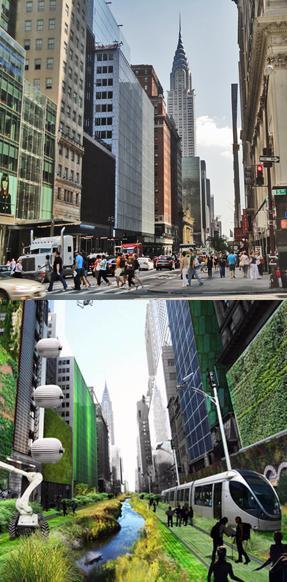How to Think About the Largest Things that We Build
May 20, 2016 — Atlanta, GA

Current image of New York City street juxtaposed with a concept of the same street as a sustainable city might look.
Cities are the largest technological artifacts that we build. We can see them from space. At the opposite end of the spectrum, we call the things that we build which can’t be seen with the naked eye “nanotechnology.” But we don’t have a name for the largest things we build other than “cities.” “City” is useful as a name because we all know what is meant when the word “city” is used even though formal definitions are surprisingly vague and inadequate. We understand a city as a very large permanent human settlement comprised of all the built, natural, human, political, and economic elements within its borders; however, we don’t really understand how the mechanical and technological systems of cities function together. How can it be that we don’t understand how cities work when we design, build, operate, maintain, and inhabit them? We are just beginning to explore the answers to this question. One of the things that we are learning is that it will be useful to distinguish between what we understand as a city, which includes all of the human elements, and the underlying technological artifacts that facilitate the feasibility of cities. Perhaps a better name for humanity’s largest artifacts, such as cities, would be “gigatechnology.”
The middle of 2009 saw the balance shift from a majority of people living in rural settings to cities as the dominant form of human habitation. The number of megacities, those with a population of ten million people or more, went from 2 in 1950 to 35 in 2015. This trend is not going away. In fact, it’s accelerating. One of the consequences of this trend is that about 12% of the global population lives in “informal settlements” near city centers that often have substandard or non-existent infrastructure. Cities offer us many advantages over rural living. They are centers of art, culture, commerce, employment, education, convenience, proximity, comfort and opportunity. These are the intended benefits of cities which attract people to become urbanites. Along with these benefits are a whole host of unintended consequences that require mitigation, such as poor air quality, water pollution, heat island effect, suburban sprawl, concentrated resource use, and concentrated wastes of all kinds, to name only a few.
Cities are currently designed and built as agglomerations of stand-alone technological systems. There is one that transports clean water to us, another to transport dirty water away from us. One system delivers electrical energy, another pipes natural gas to us. Networks of roads, rails, sidewalks, parking lots, and gas stations enable us to freely move about. Global networks of producers, suppliers, retailers, and restaurateurs give those with the means access to any kind of food prepared in any style no matter the season. But, of course, we must attend to all those unintended consequences. The current practice of designing, building, and operating infrastructure is unsustainable. Our failure to recognize the interdependencies between infrastructure components results in a sub-optimal system that is viable only because of the availability of cheap fossil fuels, non-renewable resources, and the externalization of costs, risks, and harms.
The concept of “Smart Cities” is showing promise by enabling the flow of information in, out, and among the various urban systems. This is proving to be useful in developing mitigation strategies, but it only serves to highlight that cities are not really a collection of systems that behave in a linear fashion even though they are designed that way. Making cities smarter is a step in the right direction, but does not adequately deal with the mounting unintended consequences that emerge alongside the intended ones.
It is becoming more obvious, as the complex flows of material, energy, information, and nutrients through cities are studied, that cities are non-linear, complex systems of systems that exhibit emergent properties. An emergent property is one that arises from the interactions of the components of a system that aren’t obvious from studying those components in isolation. For this reason, a traditional reductive engineering approach, that divides responsibility for individual systems amongst the relevant engineering disciplines, is showing its limitations in the face of increasing complexity.
Gigatechnology is a newly integrative and use-inspired science committed to the study of the interconnections and interdependencies inherent in very large systems, and the properties that emerge from these interactions. Some of the questions that the study of gigatechnology will begin to answer are:
- How can an ecological paradigm be used to understand urban infrastructure systems?
- What new technologies are needed to measure, model, and manage infrastructure systems-of-systems?
- What and how do properties emerge from infrastructure system’s interactions with other systems?
- How can the infrastructure ecosystem be made more sustainable, resilient, and productive?
- How best can we develop a pedagogy to teach the design and engineering of massive, open and complex infrastructure systems?
Engineers are rarely challenged to address infrastructures as a system of systems. Infrastructure is typically designed to capitalize on economies of scale (horizontal integration), and/or publicly-owned, centralized monopolies (vertical integration). Applying the notion of integration to gigatechnology systems leads us to understand them as more than horizontal or vertical, but “massively integrated.”
Designing a massively integrated system of systems that optimizes for more positive consequences and interactions while greatly minimizing the negative consequences seems like it would be an unbearably complex task. However, a model for how this might be possible already exists in the form of functioning ecosystems. Nature has been operating massively integrated systems regeneratively for a couple of billion years. While gigatechnologies like cities are manmade, the application of an ecological paradigm in their design offers us strategies that could yield unprecedented levels of sustainability.
Read more BBISS Big Ideas Stories
Brent Verrill, Communications Manager, BBISS




